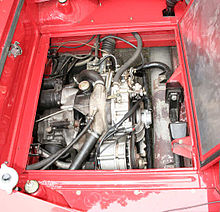NSU Wankel Spider
| NSU | |
|---|---|
|
NSU Wankel Spider
|
|
| Wankel Spider | |
| Production period: | 1964-1967 |
| Class : | Small car |
| Body versions : | Cabriolet |
| Engines: |
Wankel engine : 0.50 liters (37 kW) |
| Length: | 3580 mm |
| Width: | 1520 mm |
| Height: | 1260 mm |
| Wheelbase : | 2018 mm |
| Empty weight : | 700 kg |
The NSU Wankel-Spider is a two-seater convertible from NSU Motorenwerke AG and in 1964 it was the world's first production vehicle with a Wankel engine . Its development with the single-disc Wankel engine was the forerunner for the NSU Ro 80 with a two-disc Wankel engine.
General
The body of the Spider is only based on the basics of the NSU Sport-Prinz . Despite the external similarity, the differences are serious. Hardly any body part is identical in the Spider and Sport-Prinz. The car has a rear engine and the water cooler is located at the front of the car in order to achieve the most even weight distribution possible; the tank (35 liters) is also placed at the front. Since the Wankel engine is lower than a conventional in-line engine, there is space in the stern or above the drive unit for flat storage space, in addition to the trunk in the bow. The Wankel engine also has the advantage of a comparatively low mass, the engine weighs only 125 kg with all additional units.
The engine achieves a rather moderate torque of 72 Nm, but is very easy to turn and runs smoothly at high speeds compared to other small engines. However, speeds of more than 6000 rpm should be avoided. When accelerating without taking this recommendation into account (briefly over 7000 rpm in the lower gears), the rotary engine accelerates the small sports car from 0 to 100 km / h in 14.5 seconds.
The car cost 8,500 DM (1964) and 7,000 DM (1966). The 3,000–5,000 copies announced at the IAA in Frankfurt in 1963 could not even begin to be realized for 1964 alone. In fact, 2375 copies were made between 1964 and 1967. The Wankel Spider is a very popular classic car these days .
Technical specifications
| Vehicle type | NSU Wankel Spider | |
|---|---|---|
| Engine: | Single-disc rotary piston engine installed in the rear of the car | |
| Chamber volume: | 497.5 cc | |
| Compression: | 9.3: 1 | |
| Power: | 37 kW (50 PS) at 6000 rpm, for sports drivers there were around 10 vehicles with 48 kW (65 PS) | |
| Max. Torque : | 72 Nm at 2500 rpm (50 PS version) | |
| Cooling: | Water cooling with pump and thermostat (cooler volume early models 11.5 l, later models 9.5 l) |
|
| Lubrication: | Pressure circulating lubrication with additional oil metering pump and oil cooler | |
| Carburetor: | 1 Solex flat current 18/32 HHD | |
| Transmission: | 4-speed gearbox, fully synchronized, center shift, hydraulic clutch actuation | |
| Front suspension: | Wishbone with coil springs and anti-roll bar | |
| Rear suspension: | Semi-trailing arm with coil springs | |
| Body: | self-supporting all-steel body | |
| Steering: | Rack and pinion steering | |
| Wheelbase : | 2020 mm | |
| Track width front / rear: | 1246/1227 mm | |
| Wheel size: | 5.00-12 r | |
| Dimensions L × W × H: | 3580 × 1520 × 1260 mm | |
| Empty weight (without driver): | 700 kg | |
| Maximum weight allowed: | 950 kg | |
| Top speed: | 155 km / h (factory specification) | |
Sports use
In 1966 Karl-Heinz Panowitz became German rally champion of all classes with the NSU Wankel-Spider. In 1967 and 1968 Siegfried Spieß was German mountain champion of all classes with the NSU Wankel-Spider.
Literature and Sources
- Peter Schneider: "NSU 1873−1984 • From the high wheel to the automobile", Motorbuch Verlag, Stuttgart 1988, ISBN 3-613-01086-0
- “Auto, motor und sport” (test report), issue 18/1964, Vereinigte Motor-Verlage, Stuttgart
- Heinz Kranz: ... and he still drives - NSU Wankel Spider in the test , Hobby from October 7, 1964 (reprint on Zwischengas.com ).
Web links
Individual evidence
- ↑ a b c d e f Werner Oswald: German cars 1945–1990 . Volume 4. 1st edition. Motorbuch Verlag, Stuttgart 2001. ISBN 3-613-02131-5 . Pp. 394-397
- ^ Another report from the Frankfurt IAA. In: Automotive Technology . 11/1963, pp. 421-423.
- ^ Another report from the Frankfurt IAA. In: Automotive Technology . 11/1963, pp. 421-423.





